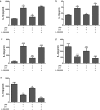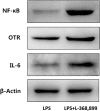Protective effect of oxytocin on LPS-induced acute lung injury in mice
- PMID: 30808956
- PMCID: PMC6391417
- DOI: 10.1038/s41598-019-39349-1
Protective effect of oxytocin on LPS-induced acute lung injury in mice
Abstract
Oxytocin (OT), a neurohypophyseal hormone synthesized in the paraventricular and supraoptic nuclei of the hypothalamus, has been reported to have an anti- inflammatory effect. However, its role in acute lung injury (ALI) has never been investigated. The aim of this study was to explore the therapeutic effects and potential mechanism action of OT on lipopolysaccharide (LPS)-induced ALI. Mice were treated with OT 30 min before the intraperitoneal injection of LPS. After 2 h, the effects of OT on lung histopathological changes, lung wet/dry (W/D) ratio, myeloperoxidase (MPO) activity, levels of inflammatory cytokines in the bronchoalveolar lavage fluid (BALF), and expression of inflammation proteins were detected. The results showed that OT significantly reduced LPS-induced pathological injury, W/D ratio, MPO activity, and the levels of interleukin (IL)-1β, IL-18 and IL-6. Further, OT also inhibited LPS-induced Toll-like receptor 4 expression and NLR family pyrin domain containing 3 inflammasome activation. OT receptor antagonist (L-368,899) was given 90 min before injecting OT to further demonstrate the role of OT in LPS-induced ALI. The results showed OT could not alleviate the aforementioned inflammatory reactions after administering L-368,899. In conclusion, the present results indicated that OT could reduce inflammatory responses of LPS-induced ALI.
Conflict of interest statement
The authors declare no competing interests.
Figures










References
Publication types
MeSH terms
Substances
LinkOut - more resources
Full Text Sources
Other Literature Sources
Research Materials
Miscellaneous

